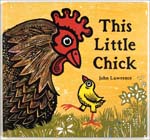Media of Picture Books - Part I
Even though all picturebooks are made with printer's ink on paper, a printed reproduction of the original art will carry some of the unique effects of the medium or media the illustrator used. An artist's choice of media will depend on many factors. Some artists work in one medium. Jerry Pinkney works exclusively in watercolor; Mary Azarian works with woodcuts; David Wisniewski's books are done with cut paper. What follows is an overview of some of the media artists have used to make illustrations for picturebooks.
A. Woodcuts
Woodcuts are among the oldest means of creating prints. The artist takes a block of wood and removes the areas the artist does not want printed, in the process creating a reverse image on the illustration. This leaves a raised surface upon which the artist will apply ink and press the block to paper. Color may be added by applying colored ink to the block or, more often, color is painted by hand into the print. Woodcuts usually have bold lines and are relatively simple in composition. Woodcuts do provide a unique look that can be very powerful and often evoke a sense of looking back into the past. Mary Azarian may be the best known of artists who make woodcuts.
B. Etching
Etching is a technique similar to woodcuts. A metal plate is coated with wax. The artist uses a tool or stylus to draw on the plate by scraping away wax. The plate is then dipped in acid and the acid burns lines into the metal. The rest of the wax is removed, ink applied to the plate, and a print is created. Again, color can be worked into the print. Arthur Geisert's illustrations are usually done by etching. Here is an example of what etching looks like from Geisert's Oink.
![]() Go to the Web Resources link for Oink to see images and get more information.
Go to the Web Resources link for Oink to see images and get more information.
C. Linoleum/Vinyl Block Prints
This technique is nearly identical to woodcuts. Linoleum/vinyl is a softer and more pliable material than wood, so the artist can make much finer lines and thus more detailed illustrations than with woodcuts. Ashely Wolff and John Lawrence are well known for their linoleum/vinyl cuts. This illustration is from John Lawrence's This Little Chick.


D. Scratchboard
In scratchboard, the artist paints black ink on a smooth, white drawing board or on a board that is made especially for scratchboard. Then the artist takes a sharp stylus and creates an image by scraping away the ink, leaving the white of the board exposed. The artist can create dramatic effects of light and shadow. The artist can also work color into the illustration by using a transparent overlay, applying the color to the board and then applying the black ink over the paint, or by painting on the completed drawing. Brian Pinkney, Michael McCurdy, and Leonard Everett Fisher are illustrators who frequently work with scratchboard.